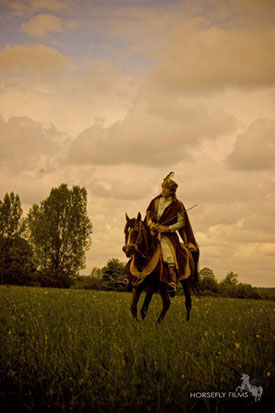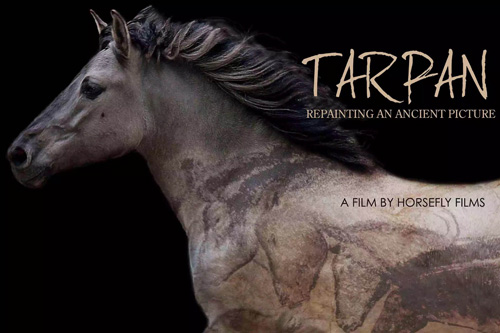 The history of the Polish-Arabian horse is complex and fascinating; others have covered it much more comprehensively. But here’s a very brief snapshot:
The history of the Polish-Arabian horse is complex and fascinating; others have covered it much more comprehensively. But here’s a very brief snapshot:
16th century: Writings in Poland mention pure-bred Arabians. Used by the Turkish army, they’re taken by Poles as spoils of war.
1699: Poland’s truce with Turkey, so – no more spoils of war. Poles travel to the desert to purchase Arabians from tribesmen and use the horses to upgrade their own, local stock. The offspring are used for cavalry, farm work and carriage pulling.
World War I: Polish Arabian studs nearly decimated. “Of the 500 Arabian broodmares in Poland in 1914, only 25 still lived in 1918” (“History’s Hooves,” March/April 1998 print edition, Saudi Aramco World).
1921: Poland has regained its independence following the war. A new Arabian breeding program is established at Janów Podlaski Stud.
1920s: The Arabian Horse Breeding Society is formed in Poland; its first Stud book is published.
1930s: A few Americans import Polish Arabians (notably, Henry B. Babson of Chicago and J.M. Dickinson of Tennessee).
World War II: Poland loses 89 percent of its broodmares (“History’s Hooves”). More than 80 percent of Janów Podlaski’s horses perish in the 1939 war campaign; the Stud is severely damaged. But some horses are saved by Polish horsemen determined to keep the Polish Arabian in Poland.
Post-World War II: Hungary sends Arabian mares to Poland to help rebuild Poland’s breeding program. The Polish Stud also uses Russian Arabians for that same purpose.
Late 1950s: British breeder Patricia Lindsay buys Polish Arabians for her own program and becomes a purchasing agent for Americans.
Today: Poland has three state Studs – Janów Podlaski, Michałów and Białka – as well as private Studs, and “proudly serves as the wellspring for the greatest Arabian horses in the world,” according to Horsefly Film’s trailer for their new documentary film, “Path to Glory: The Rise and Rise of the Polish Arabian horse.” Read Justine Jablonska’s interview with the filmmakers here.
CR
Imagery
Janów Podlaski Stud, Reenactment shot of Polish Count Rzewuski, who brought Arabian horses from Bedouin lands to Poland. The count disappeared after the battle of Daszów, on May 14, 1831 during the November Uprising against Russia. His white stallion returned alone – bloodstained, no saddle or bridle. The Russians confiscated all the count’s horses. Some said that the count had not perished, but was back in the East – along with some of his horses, who he’d led to freedom there.
Photo courtesy of Horsefly Films




Pingback: The Future Of The Polish Arabian Horses | The Flying Shetlands
Pingback: The Hazy Future of the Polish Arabian | HORSE NATION
Enjoyed your article.
I suspect I have inadvertently purchased a polish Arabian mare sold as a quarter horse. from reading she seems to have the confirmation and temperament of the above.unfortunately, her owner purported to notknow the name of her previous owner, so, after vet checking etc.,and her chewing and yawning around me I bought her. vet. , after checking her teeth felt she is around 12 yrs old.i have no intention of selling her. I had my last horse (saddlebred ) for 1 mos less than 11 yrs . he and I both just couldn’t fight his many crisis (healthwise )throughtout 2.5 yrs. he would improve but then hit another crisis. I knew we didn’t have much more time left together 1 yr. ago and so we allowed him to cross the rainbow bridge.echo is the most accommodating loving horse I have ever had the pleasure of meeting.is there a way I could find out her genetic history . I have tried one or 2 beginner dressage moves and after 3 x she had it. I am not a dressage rider but have had lessons.just so you know I have no intention of competing. at 73 I prefer to be a pleasure rider hope you have some ideas
What about the very important era of the aristocrats (Sanguszko, Czartoryski etc., etc.), that cannot be skipped over.
Pingback: Equestrian art – BeaCreation
Palas was brought to Poland in 1972, I don’t think there were any Russian Arabians before then. So Poland no longer need to rebuild as their stock was already going strong. Russia brought a group of Arabians to Poland in the spirit of friendship. The Russianbreds clobbered the Polish Arabians in the races that were held. Which was no surprise, Tersk breeds more for speed and has different training methods. But the important thing, Poland was very interested in Palas and eventually purchased the stallion.
Hungary most certainly did NOT send Arabian mares to Poland to help rebuild. After the war, the US came across some mares which they ordered sent to a serum factory. The Polish State Stud received a request for work horses and in turn they would trade for these mares. Poland accepted and the “B” girls came to Poland.
Poland sent a request to Hungary for the pedigrees of these mares and Hungary sent them. But then after the mares had several foals, Hungary wanted their mares back. Poland complied and they were allowed to keep the foals. There are some very famous and excellent Arabian horses that descended from the Babolna mares.
Pingback: Original Pony | TurkeyPickle
Could you give me any information that during WW 2 , a number of Polish Arbians were going to be put down ? The understanding I have is that they were sent to Canada for quarantine until they could be brought to the U.S. I owned one of these horses, the Never Die Wietz ( sp.? ) line . He was a beautiful stud , very well mannered , and an all around fantastic animal. Could you please give me any information on these supposedly polish horses ? Thank you, Bob Roy
Pingback: 6 Main Types of Purebred Arabian Horses | Helpful Horse Hints
What ever happened to the polish-Arabian horse during the WW-2